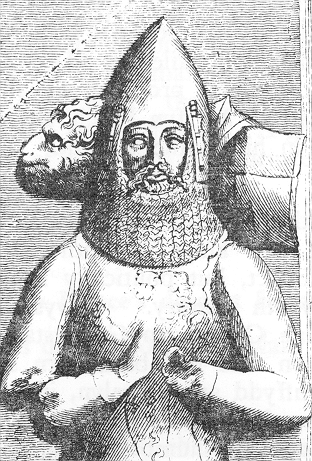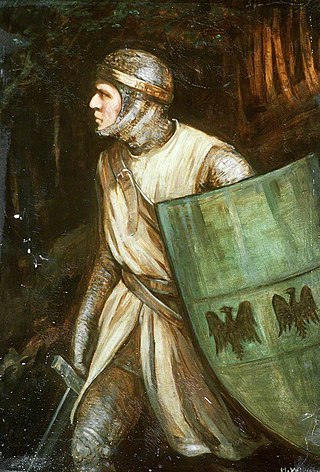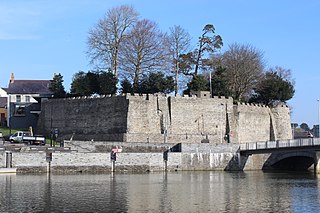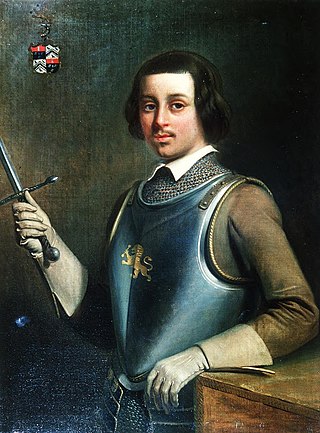
Rhys ap Gruffydd or ap Gruffudd was the ruler of the kingdom of Deheubarth in south Wales from 1155 to 1197. Today, he is commonly known as The Lord Rhys, in Welsh Yr Arglwydd Rhys, although this title may have not been used in his lifetime. He usually used the title "Proprietary Prince of Deheubarth" or "Prince of South Wales", but two documents have been discovered in which he uses the title "Prince of Wales" or "Prince of the Welsh". Rhys was one of the most successful and powerful Welsh princes, and, after the death of Owain Gwynedd of Gwynedd in 1170, the dominant power in Wales.

Owain ap Gruffudd was King of Gwynedd, North Wales, from 1137 until his death in 1170, succeeding his father Gruffudd ap Cynan. He was called Owain the Great and the first to be styled "Prince of Wales", and the "Prince of the Welsh". He is considered to be the most successful of all the North Welsh princes prior to his grandson, Llywelyn the Great. He became known as Owain Gwynedd to distinguish him from the contemporary king of Powys Wenwynwyn, Owain ap Gruffydd ap Maredudd, who became known as Owain Cyfeiliog.

Gruffudd ap Cynan, sometimes written as Gruffydd ap Cynan, was King of Gwynedd from 1081 until his death in 1137. In the course of a long and eventful life, he became a key figure in Welsh resistance to Norman rule.

Deheubarth was a regional name for the realms of south Wales, particularly as opposed to Gwynedd. It is now used as a shorthand for the various realms united under the House of Dinefwr, but that Deheubarth itself was not considered a proper kingdom on the model of Gwynedd, Powys, or Dyfed is shown by its rendering in Latin as dextralis pars or as Britonnes dexterales and not as a named land. In the oldest British writers, Deheubarth was used for all of modern Wales to distinguish it from Hen Ogledd, the northern lands whence Cunedda originated.

Rhys ap Tewdwr was a king of Deheubarth in Wales and member of the Dinefwr dynasty, a branch descended from Rhodri the Great. Following the Norman Conquest, he had to pay William the Conqueror to keep his kingdom, which lasted until the end of William's reign.
Gruffydd ap Rhys was Prince of Deheubarth, in Wales. His sister was the Princess Nest ferch Rhys. He was the father of Rhys ap Gruffydd, known as 'The Lord Rhys', who was one of the most successful rulers of Deheubarth during this period.
Richard fitz Gilbert de Clare 3rd feudal baron of Clare in Suffolk, was an Anglo-Norman nobleman. A marcher lord in Wales, he was also the founder of Tonbridge Priory in Kent.

Cardigan Castle is a castle overlooking the River Teifi in Cardigan, Ceredigion, Wales. It is a Grade I listed building. The castle dates from the late 11th-century, though was rebuilt in 1244. Castle Green House was built inside the castle walls in the early 1800s. After falling into disrepair the castle was restored in the early 2000s and opened to the public in 2015. It is owned by Ceredigion County Council and now includes a heritage centre and open-air concert facilities. The castle's gardens are listed on the Cadw/ICOMOS Register of Parks and Gardens of Special Historic Interest in Wales.
Gwenllian ferch Gruffydd was Princess consort of Deheubarth in Wales, and married to Gruffydd ap Rhys, Prince of Deheubarth. Gwenllian was the daughter of Gruffudd ap Cynan (1055–1137), Prince of Gwynedd and Angharad ferch Owain, and a member of the princely Aberffraw family of Gwynedd. Gwenllian's "patriotic revolt" and subsequent death in battle at Kidwelly Castle contributed to the Great Revolt of 1136.
Anarawd ap Gruffydd was a Prince of Deheubarth in Southwest Wales.
Cadwaladr ap Gruffydd was the third son of Gruffudd ap Cynan, King of Gwynedd, and brother of Owain Gwynedd.

Rhys Gryg, real name Rhys ap Rhys, also known as Rhys Fychan, was a Welsh prince who ruled part of the Kingdom of Deheubarth.
Robert fitz Martin was a knight from Devon whose father, Martin de Turribus, was the first Norman Lord of Kemes, in what had previously been the Dyfed part of Deheubarth. Fitz Martin inherited the Lordship of Kemes from his father, and founded St Dogmaels Abbey c. 1118. He was the first of the FitzMartin line. His descendants continued to hold lands in England and Wales until the 14th century.

The Norman invasion of Wales began shortly after the Norman conquest of England under William the Conqueror, who believed England to be his birthright. Initially (1067–1081), the invasion of Wales was not undertaken with the fervour and purpose of the invasion of England. However, a much stronger Norman invasion began in 1081 and by 1094 most of Wales was under the control of William's son and heir, the later King William II. The Welsh greatly disliked the "gratuitously cruel" Normans, and by 1101, had regained control of the greater part of their country under the long reign of King Gruffudd ap Cynan, who had been imprisoned by the Normans for twelve years before his escape.

The Royal House of Dinefwr was a cadet branch of the Royal House of Gwynedd, founded by King Cadell ap Rhodri, son of Rhodri the Great. Their ancestor, Cunedda Wledig, born in late Roman Britain, was a Sub-Roman warlord who founded the Kingdom of Gwynedd during the 5th century, following the Anglo-Saxon settlement of Britain. As Celtic Britons, the House of Dinefwr was ruling before the Norman conquest, having to fight with their neighbors such as the Celtics, Anglo-Saxons and Vikings, before struggling with the Normans afterwards. Many members of this family were influential in Welsh history, such as Hywel Dda, who codified Welsh law under his rule, and achieved the important title of King of the Britons, or Lord Rhys, Prince of Wales, who rebelled against Richard the Lionheart, and became one of the most powerful Welsh leaders of the Middle ages.
This article is about the particular significance of the century 1101–1200 to Wales and its people.

Wales in the High Middle Ages covers the 11th to 13th centuries in Welsh history. Beginning shortly before the Norman invasion of the 1060s and ending with the Conquest of Wales by Edward I between 1278 and 1283, it was a period of significant political, cultural and social change for the country.

Wales in the Middle Ages covers the history of the country that is now called Wales, from the departure of the Romans in the early fifth century to the annexation of Wales into the Kingdom of England in the early sixteenth century. This period of about 1,000 years saw the development of regional Welsh kingdoms, Celtic conflict with the Anglo-Saxons, reducing Celtic territories, and conflict between the Welsh and the Anglo-Normans from the 11th century.

The history of Gwynedd in the High Middle Ages is a period in the History of Wales spanning the 11th through the 13th centuries. Gwynedd, located in the north of Wales, eventually became the most dominant of Welsh polities during this period. Contact with continental courts allowed for Gwynedd to transition from a petty kingdom into an increasingly sophisticated principality of seasoned courtiers capable of high level deplomacy and representation; not only with the Angevine kings, but also the king of France and the Papal See. Distinctive achievements in Gwynedd include further development of Medieval Welsh literature, particularly poets known as the Beirdd y Tywysogion associated with the court of Gwynedd; the reformation of bardic schools; and the continued development of Cyfraith Hywel. All three of these further contributed to the development of a Welsh national identity in the face of Anglo-Norman encroachment of Wales.











